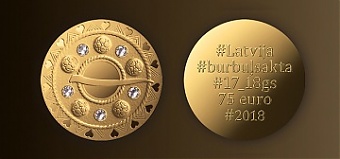Banks, Financial Services, Good for Business, Latvia
International Internet Magazine. Baltic States news & analytics
Friday, 19.04.2024, 18:40
Latvijas Banka issues a collector coin "Gold Brooches. The Bubble Fibula"
 Print version
Print version |
|---|
In November 2016, the collector coin replicating a disc fibula was issued; the coin featuring a horseshoe fibula was minted in August 2017; and this year, when we celebrate Latvia's centenary, the series is concluded with a special gold collector coin, adorned with crystals like in the historical original design. Moreover, a set of all three gold coins will also be available.
For several centuries bubble fibulae were characteristic for the territory of the present-day Latvia: the luxurious brooches worn by women represented not just ordinary jewellery but also significant value of that time. They became an integral part of the Latvian national costumes. Latvijas Banka's gold collector coin dedicated to bubble fibula will also be special among the gifts dedicated to Latvia on its centenary: it will be as a significant and valuable reminder of this historical milestone in gold as a token of our cultural and historical experience.
The coin series dedicated to brooches, i.e. the three most characteristic pieces of jewellery worn on the territory of the present-day Latvia in different centuries now replicated in the coin design, is a luxurious gift to Latvia on its anniversary.
The author of the graphic design of the collector coin "Gold Brooches. The Bubble Fibula" is Ingūna Elere, and the plaster model was created by Jānis Strupulis. Ingūna Elere is the author of all three coins of the gold brooches series.
The coin "Gold Brooches. The Bubble Fibula" was minted by Münze Österreich Aktiengesellschaft (Austria). Inscriptions "#Latvija", "#pakavsakta", "#17_18gs", "75 euro" and "#2018" are depicted on the obverse of the gold coin, while the reverse features a stylised image of a 17th century bubble fibula.
According to the concept of artist Ingūna Elere, the brooch featured on the coin provides centuries-old information, while the hashtags highlighting the times we live in are located on the obverse of the coin. The brooch tells us a story about ancient times in Latvia's history, but the reverse of the coin – about the present day, i.e. how we communicate in the virtual environment and social networks, and how we mark topics important to us.
The history of the brooch in the territory of Latvia began with various brooches from the early Iron Age (1st–4th century AD) – the so-called eye fibulae, tutulus fibulae, cross-ribbed fibulae, arbalest fibulae and round disc fibulae with openwork wheel, cross and fire cross motifs. The older brooches were imported, but soon the local craftsmen began to use them as models to make their own brooches, with their form reflecting the local aesthetic and mental concepts. Brooches were used to fasten and adorn clothing by all – men, women and children. The form of and ornamentation on brooches also served a protective function (jewellery as amulet). The form, size and material may have changed, yet the brooches have remained popular until the present day.
It was in the 17th century that the range of Latvian jewellery was supplemented by a new type of fibulae that gradually emerged from the range of various ring fibulae popular in past centuries. Their circle featured hemispheric elevations or bubbles, which gave the name to the jewellery – the bubble fibulae.
The large, luxurious bubble fibulae were made of silver and often they were even gold plated. The bubble fibulae represented one of the most gorgeous jewellery of Latvian women. The names of fibulae owners and the year of their making or the year they were given as a gift were often carved on them.
The bubble fibulae were common throughout the territory of Latvia, although the way they were decorated and their wearing traditions were slightly different. For instance, it was in South Courland where two or more such fibulae, not just one, were fastened to the shawl. They were placed one on top of the other according to their size and topped with a silk ribbon. Wealthy Latvian female farmers were proud of their luxurious brooches, which were often handed down from generation to generation. Such fibulae have often been preserved by families up to the present day as relics of their ancestors.








 «The Baltic Course» Is Sold and Stays in Business!
«The Baltic Course» Is Sold and Stays in Business!

